Teens and Vaping: What Caring Adults Should Know About Electronic Cigarette Use (YD1944, Jan. 2020)
Availability: Web only
E-cigarettes (e-cigs), also known as “vapes,” are designed to deliver nicotine, flavorings, THC (marijuana) and other additives through a liquid that turns into a vapor.
Vaping is the act of inhaling and exhaling vapor produced by an e-cigarette. It is called vaping because of the vapor cloud given off during use.
■ Many youth use the term Juuling (named after a vape device called JUUL).
(CDC, 2018)
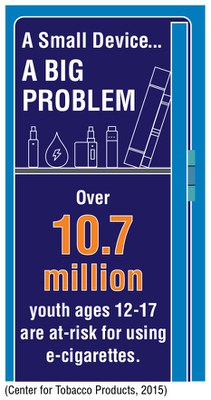
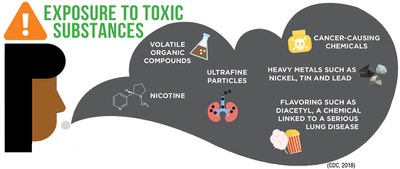
Vaping Myths and Facts
■ Myth: “It’s just water vapor.” Fact: Vaping can expose the user’s lungs to harmful chemicals such as formaldehyde and carcinogens.
■ Myth: “It’s just flavoring.” Fact: Vapes get their flavors from chemicals.
While these flavorings are safe to eat in food, they are NOT safe to inhale.
■ Myth: “Vapes don’t have nicotine.” Fact: Most vapes DO contain nicotine. Some vapes claim they are nicotine-free but are not.
■ Myth: “Nicotine isn’t that bad for me.” Fact: Nicotine exposure during teen years disrupts brain development and causes permanent damage.
■ Myth: “There’s no way I’ll become addicted.” Fact: Vaping, like cigarettes, delivers nicotine to the brain in as little as 10 seconds. A teen’s brain is still developing, making it more vulnerable to nicotine addiction.
■ Myth: “Just because I vape doesn’t mean I’m going to smoke cigarettes.” Fact: Evidence suggests teens who vape are more likely to try smoking cigarettes in the future.
(Ambrose et al., 2014; CDC, 2018; CDC, 2019a)
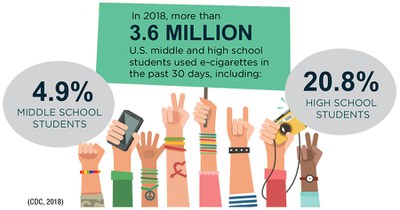
RISKS FOR YOUTH:
◆ Between 2017 and 2018, vaping among high school students increased by 78%.
◆ E-cigarettes are the most commonly used tobacco product among teens ages 12 to 18.
◆ All JUUL e-cigs have a high level of nicotine. A typical cartridge, or “pod,” contains about as much nicotine as a pack of 20 regular cigarettes.
◆ E-cigs pose a higher risk for developing “popcorn lung,” a serious lung disease that causes coughing, shortness of breath and symptoms similar to chronic obstructive pulmonary disease (COPD).
◆ As of November 2019, the U.S. has had 2,051 hospitalizations, with the death toll rising to 39, due to vaping-related causes.
◆ Nicotine exposure can negatively impact learning, memory, attention and long-term respiratory health, as well as potentially increase impulsivity and the development of mood disorders.
(American Lung Association, 2016; CDC, 2018; CDC, 2019a)
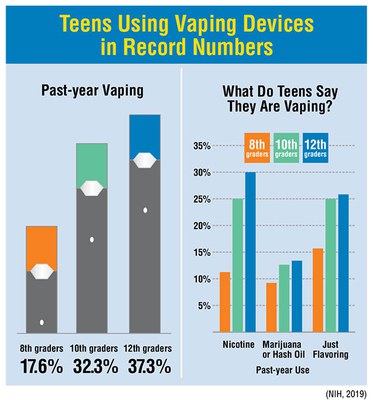
E-cigarette use has become an epidemic among our nation’s young people.
(CDC, 2019b)
Most Common Reasons Youth Use E-cigs:
◆ Their friends, classmates or family members use
◆ Availability of flavors, such as mint, candy or fruit
◆ Believe e-cigs are less harmful than other forms of tobacco, such as cigarettes
◆ Some emit very low amounts of vapor, making them easier to use discreetly than cigarettes
◆ Access: online purchasing and retail locations do not implement strict age verification processes
◆ Social media attention and mass marketing directed at youth make it more appealing
◆ To experiment, out of boredom or curiosity or to relieve stress
(Pentz et al., 2015)
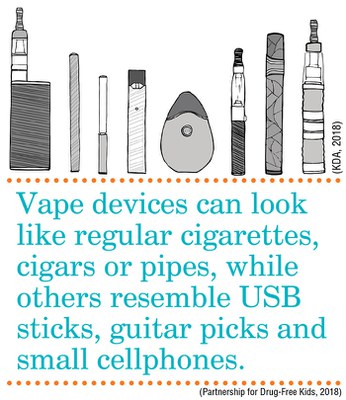
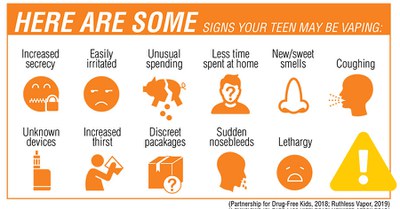
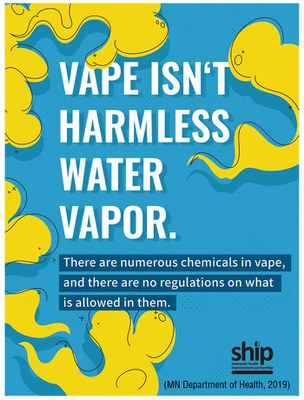
WARNING!
Accidental Poisoning
Calls to poison control centers involving e-cigs jumped from one per month in 2010 to 215 per month in 2014. The liquid in e-cigs can be toxic if someone drinks, sniffs or touches it. Children under 5 years old made up more than half of the poisoning cases.
Poison Control Center: (800) 222-1222
(Scholastic, 2015)
 THE BOTTOM LINE:
THE BOTTOM LINE:
Set a good example by being tobacco-free. If you use tobacco products, it is never too late to quit. Talk to a health-care professional, or for free
help, visit https://smokefree.gov or call 1-800-QUIT-NOW. Educate teens and get the conversation about vaping started:
■ Download the NDSU Extension publication:
“A Parent’s Role in Substance Use Prevention: Tips for Talking to Youth of All Ages” (YD1912) to understand your role as a caregiver and what you can do to prevent the use of e-cigarettes.
REFERENCES:
Ambrose, B., Rostron, B., Johnson, S., Portnoy, D., Apelberg, B., Kaufman, A., & Choiniere, C. (2014). Perceptions of the relative harm of cigarettes and e-cigarettes among U.S. youth. American Journal of Preventive Medicine, 47, 53-60.
www.sciencedirect.com/science/article/pii/S0749379714001834
American Lung Association. (2016). www.lung.org/about-us/blog/2016/07/popcorn-lung-risk-ecigs.html
Centers for Disease Control and Prevention (CDC). (2018). www.cdc.gov/tobacco/basic_information/e-cigarettes/about-e-cigarettes.html
Centers for Disease Control and Prevention (CDC). (2019a). https://www.cdc.gov/tobacco/basic_information/e-cigarettes/severe-lung-disease.html
Centers for Disease Control and Prevention (CDC). (2019b). https://www.cdc.gov/tobacco/basic_information/e-cigarettes/surgeon-general-advisory/index.html
Center for Tobacco Products. (2015). www.scholastic.com/youthvapingrisks/pdfs/YoutheCigarettePreventionInfographic
FINAL.PDF
Kansas Dental Association (KDA). (2018). www.ksdental.org/home/news-details/2018/12/19/u.s.-surgeon-general-releases-advisory-on-e-cigarette-epidemic-among-youth
Minnesota Department of Health. (2019). www.health.state.mn.us/communities/tobacco/ecigarettes/docs/schooltoolkit.pdf
News in Health (NIH). (2019). https://newsinhealth.nih.gov/2019/02/vaping-rises-among-teens
Partnership for Drug-Free Kids. (2018). https://drugfree.org/article/how-to-talk-with-your-kids-about-vaping
Pentz, M., Shin, H., Riggs, N., Unger, J., Collison, K., & Chou, C. (2015). Parent, peer, and executive function relationships to early adolescent e-cigarette use: A substance use pathway? Addictive Behaviors, 42, 73-78. https://www.sciencedirect.com/science/article/pii/S0306460314003724
Ruthless Vapor. (2019). www.ruthlessvapor.com/blogs/ruthless-e-liquid/teen-vaping#section5
Scholastic. (2015). http://headsup.scholastic.com/students/e-cigarettes-what-you-need-to-know
ADDITIONAL RESOURCES:
◆ “The Real Cost” Youth E-Cigarette Prevention Campaign
Reviewed by: Extension Agents Vanessa Hoines, Liz Larson, Alice Westby, Amelia Doll, Caroline Homan, Cindy Klapperich; Chloe Krinke, M.Ed., LAPC, NCC; Kim Bushaw, Extension Family Science Specialist; Brady Weaver, Tobacco Prevention and Control

